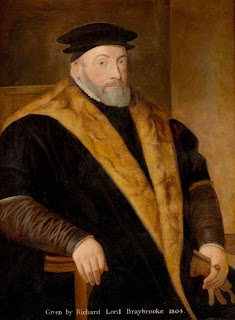The initial withholding of the office and title of chancellor from Audley, when he was named keeper of the great seal in May 1532, has yet to be explained. On 26 Jan. 1533, however, with the new parliamentary session only ten days away, he was made chancellor, and as soon as it opened he was succeeded as Speaker by Humphrey Wingfield. From then until the end of this Parliament, and at its successor of June 1536, Audley conducted business in the Lords, as More had done before him, without being a peer or having a vote. The most important Acts which passed the Upper House under his presidency also owed not a little to his legal skill: thus in the seventh session, the second to be held in 1534, the Act for first fruits and tenths (26 Hen. VIII, c.3) and that on murder and felonies in Wales (26 Hen. VIII, c.6) may have been largely his, and he polished, if he did not draft, the Treason Act (26 Hen. VIII, c.13). He was, however, not impeccable as is shown by the shortcomings in the bill he drafted for the suspension of Poynings’ Law, which required amendment shortly after its enactment in 1536 by the Irish Parliament; it may also have been through his negligence that the same Parliament had to pass a second subsidy Act. In 1539 he introduced, among others, bills for the law reform which, although rejected or allowed to lapse then, were to pass a year later as the Acts for wills (32 Hen. VIII, c.1), limiting prescriptions (32 Hen. VIII, c.2) and for shortening of the Trinity term (32 Hen. VIII, c.21). He also presented a memorial to the Lords in 1540 outlining several reforms, from which emerged Acts for lessees of lands (32 Hen. VIII, c.28) and against wrongful disseisin (32 Hen. VIII, c.33). After Cromwell’s fall the devising of government legislation became Audley’s undivided responsibility.
The same biography notes his participation in several trials, including that of Thomas More, and some confusion about his religious beliefs (was Audley a Catholic or a Protestant?):
Audley’s religious position is difficult to assess. A correspondent of Melanchthon named him with Cromwell and Cranmer as friends to Protestantism but, if he was, the friendship was always qualified by his allegiance to the King whose policies he faithfully carried out, a course which in general gives an impression of conservatism. Thus an anonymous enthusiast for the Act of Six Articles (31 Hen. VIII, c.14) again linked Audley with Cromwell as two men who, this time in contrast to Cranmer and to other bishops, had been ‘as good as we can desire’ in the furtherance of the measure. Audley was equally content to follow Cromwell’s lead and what few clashes there were between them arose largely out of minor questions of patronage.12
Whatever Audley owed to Cromwell for his success, he served Henry VIII to coordinate the Attainder and condemnation of the Earl of Essex in 1542. Audley died in 1544 without a male heir and his baronetcy was extinct at this death. He was buried in the church of St. Mary the Virgin in Saffron Walden. Audley had purchased Walden Abbey and built his home there as Baron Audley of Walden. His Audley End was replaced, however, by the Jacobean manor house built by his grandson, Thomas Howard, the 1st Earl of Suffolk; it is now an English Heritage site.
Audley's daughter Margaret married first Lord Henry Dudley, the youngest son of John Dudley, the Earl of Northumberland who was executed during the reign of Mary I and then Thomas Howard, the 4th Duke of Norfolk who was executed during reign of Elizabeth I (but after Margaret had died in 1564). When she died, their son Thomas Howard inherited Audley End and the other properties at Saffron Walden--and yes, the name does refer to the valuable spice saffron as the saffron crocus was grown in the area, and is again today.

As always thank you for your excellent blog.
ReplyDeleteWhat comes through loud and clear again and again is that the Virgin Queen was more bloody than her sister.
Suddenly, I cannot judge people. I cannot decide who is right or wrong.
ReplyDeleteAll we can judge is their actions, of course. Sir Thomas Audley's actions were acceptable only according to the standard of doing whatever his king wanted him to do. St. Thomas More followed a different standard of being the King's faithful servant and God's first.
Delete